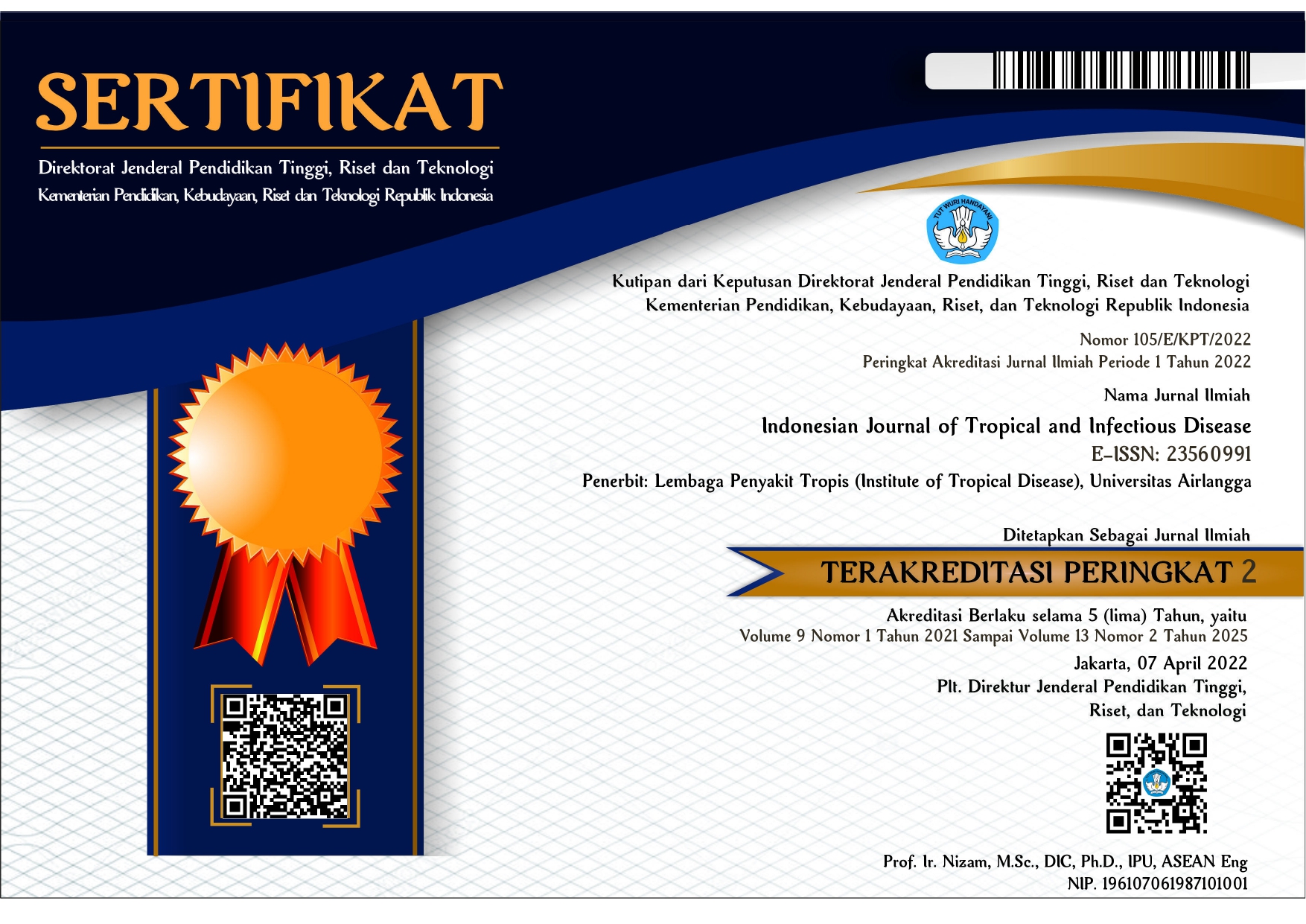Red Laser-Activated Silver Nanoparticles from Green Synthesis Extract of Butterfly Pea for Antimicrobial Photodynamic Therapy Against Staphylococcus aureus
Downloads
This study investigated the potential of photodynamic therapy (PDT) using green-synthesized silver nanoparticles (AgNPs) derived from butterfly pea extract (Clitoria ternatea L.) to combat Staphylococcus aureus (S. aureus). The use of a red diode laser as a method for enhancing the antimicrobial activity of AgNPs presents a novel approach to treating bacterial infections. The red diode laser is crucial, as it activates the AgNPs, enhancing their antimicrobial properties. This combination of light, natural extract, and nanoparticles underscores the innovative approach of using PDT in treating bacterial infections. By integrating these elements, the study aims to provide insights into effective, biocompatible treatments for antibiotic-resistant bacteria. The primary objective of this study is to synthesize and characterize AgNPs using butterfly pea extract and evaluate their effectiveness against S. aureus when combined with red laser irradiation. Silver nanoparticles were synthesized using an environmentally friendly method that processes butterfly pea extract as the reducing agent for the synthesis of the nanoparticles. Using UV-Vis spectrophotometry to track the creation of silver nanoparticles (AgNPs), it was determined that the butterfly pea extract was an effective source of nanoparticles. The particle size distribution and peak absorbance wavelength were determined by characterization utilizing a Particle Size Analyzer (PSA). Tryptic soy agar (TSA) plates were used to investigate the antibacterial activity of AgNPs against Staphylococcus aureus (S. aureus). The effectiveness of photoinactivation against S. aureus was evaluated by exposing AgNPs at a concentration of 1 mM to a red diode laser for 90 seconds. The results showed that the produced AgNPs had potential antibacterial capabilities when combined with red light therapy. The results demonstrated that the synthesized silver nanoparticles can effectively kill or inhibit the growth of Staphylococcus aureus (S. aureus) when exposed to a red diode laser for 90 seconds. The findings suggest that photodynamic therapy using green-synthesized AgNPs and red laser irradiation could be a promising approach to controlling bacterial infections like S. aureus. Further research is recommended to explore the underlying mechanisms of photoinactivation and to optimize treatment parameters for in vivo applications on experimental animals.
Taylor, T. A., & Unakal, C. G. (2023). Staphylococcus aureus Infection. Treasure Island (FL): StatPearls Publishing. Waghmode, S., Chavan, P., Kalyankar, V., & Dagade, S. (2013). Synthesis of silver nanoparticles using Triticum aestivum and its effect on peroxide catalytic activity and toxicology. J Chem. https://doi.org/10.1155/2013/265864
Sahu MK, Yadav R, Tiwari SP (2023) Recent advances in nanotechnology. Int J Nanomater Nanotechnol Nanomed 9(2): 015-023. DOI: 10.17352/2455-3492.000053
Loza, K., Diendorf, J., Sengstock, C., Ruiz-Gonzalez, L., Gonzalez-Calbet, J. M., Vallet-Regi, M., Köller, M., & Epple, M. (2014). The dissolution and biological effects of silver nanoparticles in biological media.
Jeon, Y.N. et al. (2024) ‘Green Synthesis of Silver Nanoparticle Using Black Mulberry and Characterization, Phytochemical, and Bioactivity’, Antibiotics, 13(8). Available at: https://doi.org/10.3390/antibiotics1308068
Abada, E. et al. (2024) ‘Review green synthesis of silver nanoparticles by using plant extracts and their antimicrobial activity’, Saudi J Bio Sci. Elsevier B.V. Available at: https://doi.org/10.1016/j.sjbs.2023.103877.
Rauwel, P., Küünal, S., Ferdov, S., & Rauwel, E. (2015). A review on the green synthesis of silver nanoparticles and their morphologies studied via TEM. In Advances in Materials Science and Engineering (Vol.2015). Hindawi Publishing Corporation. https://doi.org/10.1155/2015/682749
Siti Zulaicha, A., Syahjoko Saputra, I., Puspita Sari, I., Alvien Ghifari, M., Yulizar, Y., & Nopiandi Permana, Y. (2021). Green Synthesis Nanopartikel Perak (AgNPs) Menggunakan Bioreduktor Alami Ekstrak Daun Ilalang (Imperata cylindrica L). In RJNAS] Rafflesia J Nat Appl Sci (Vol. 2021, Issue 1).
Marpaung, A.M. (2020) ‘Tinjauan manfaat bunga telang (clitoria ternatea l.) bagi kesehatan manusia’, J Func Food Nutraceutical, 1(2), pp. 63–85. Available at: https://doi.org/10.33555/jffn.v1i2.30.
Khwannimit, D., Maungchang, R. and Rattanakit, P. (2020) ‘Green synthesis of silver nanoparticles using Clitoria ternatea flower: an efficient catalyst for removal of methyl orange’, Int J Env Anal Chem, pp. 1–17. Available at: https://doi.org/10.1080/03067319.2020.1793974.
Bemis, R. et al. (2023) ‘Green Synthesis of Silver Nanoparticles Using Areca Catechu L Peel Bioreductor as an Antibacterial Escherichia Coli and Staphylococcus Aureus’, IJCA (Indonesian J Chem Anal), 6(2), pp. 176–186. Available at: https://doi.org/10.20885/ijca.vol6.iss2.art9.
Yaqubi, A. K., Astuti, S. D., Zaidan, A. H., Purnobasuki, H., & Kusumawati, D. (2024). The use of ozone, hydro cooling, and heat shock technology to provide shelf life and flavonoid levels in bay leaf (Syzygium polyanthum). In AIP Conference Proceedings (Vol. 3047, No. 1). AIP Publishing. https://doi.org/10.1063/5.0194131
Moradi Eslami, L. et al. (2019) ‘The comparison of intracanal medicaments, diode laser and photodynamic therapy on removing the biofilm of Enterococcus faecalis and Candida albicans in the root canal system (ex-vivo study)’, Photodiagnosis and Photodynamic Therapy, 26, pp. 157–161. Available at: https://doi.org/10.1016/j.pdpdt.2019.01.033.
Prasetiowati, A. L., Prasetya, A. T., Wardani, S., Kimia, J., Matematika, F., Ilmu, D., & Alam, P. (2018). Indonesian Journal of Chemical Science Sintesis Nanopartikel Perak dengan Bioreduktor Ekstrak Daun Belimbing Wuluh (Averrhoa Bilimbi L.) sebagai Antibakteri. In J. Chem. Sci (Vol. 7, Issue 2). http://journal.unnes.ac.id/sju/index.php/ijcs
Widjajanti, H., Aminah, N., Muharni, M., & Arwinsyah, A. (2023). Processing of butterfly pea flowers (Clitoria Ternatea) as a drink rich in antioxidants and natural food coloring. Altifani J Res Comm Service, 3(3), 423–431. https://doi.org/10.59395/altifani.v3i3 .399
Astuti, S. D., Muhamad, A. B., Rahmatillah, A., Yaqubi, A. K., Susilo, Y., & Aji, A. K. (2023). Electronic Nose (E-Nose) for quality detection of Tuna (Thunnus thynnus) contaminated bacteria. Indonesian J. Trop. Infect. Disease, 11(1), 52-65. 10.20473/ijtid.v11i1.39206
Dwistika, R. (2018). Characteristics of Silver Nanoparticles From Electrolysis Techniques Based on Uv-Vis Spectrophotometer Amd Particle Size Analyzer (Psa) Test.
Mufid, A., & Mochammad Zainuri, S. (2016). Synthesis And Characterization Of Composite Lithium Phosphate Ferro / Grafite With Various Of Weight Fraction Grafite By Solid State Methods.
Dwi Cahyani, A. (2023). Green Synthesis of Silver Nanoparticles from Moringa (Moringa Oleifera) Leaf Extract and Their Activity Test Against Escherichia Coli and Staphylococcus Aureus Bacteria. 1–111.
Rashid, M., & Sabir, S. (2014). Biosynthesis of Self-Dispersed Silver Colloidal Particles Using the Aqueous Extract of P. peruviana for Sensing dl -Alanine. ISRN Nanotechnology, 2014, 1–7. https://doi.org/10.1155/2014/670780
Ndikau, M., Noah, N. M., Andala, D. M., & Masika, E. (2017). Green Synthesis and Characterization of Silver Nanoparticles Using Citrullus lanatus Fruit Rind Extract. Int J Anal Chem, 2017. https://doi.org/10.1155/2017/810850 4
Dyah Astuti, S., Fitria Puspasari, R., & Intan Pertiwi, W. (2020). Photodynamic Effect of Red Diode Laser with Exogenous Methylene Blue on Staphylococcus aureus Biofilm. In Postgraduate Bioscience Journal (Vol. 22, Issue 1).
Yaqubi, A. K., Astuti, S. D., Zaidan, A. H., & Nurdin, D. Z. I. (2023). Blue Laser-Activated Silver Nanoparticles from Grape Seed Extract for Photodynamic Antimicrobial Therapy Against Escherichia coli and Staphylococcus aureus. Journal of Lasers in Medical Sciences, 14
Astuti SD, Tirtana RD, Mahmud AF, Mawaddah A, Abdurachman and Yasin M, 2020, Ultraviolet (UV) Activation Effect on Antibacterial Agents of Red Betel (Piper Crocatum) Extract to Streptococcus mutans, International Symposium on Nanoscience & Nanotechnology in Life Sciences 2017, Journal of Physics Conference Series, 1445 (2020) 012004
Sunarko SA, Ekasari W, and Astuti SD. Antimicrobial effect of pleomeleangustifolia pheophytin A activation with diode laser to streptococcus mutans. J Physics: Conference Series. 853. 2017;012039doi:10.1088/1742-6596/853/1/01203 9
Astuti S.D. Mahmud A.F, Putra A.P, Setiawatie E.M. and Arifianto D. Effectiveness of Bacterial Biofilms Photodynamic Inactivation Mediated by Curcumin Extract, Nanodoxycycline and Laser Diode, Biomedical Photonic, (2020). T9(4):4 14. doi: 10.24931/2413–9432–2020- 9–4–4–14
Yaqubi, A. K., Astuti, S. D., Zaidan, H., Syahrom, A., & Nurdin, D. Z. I. (2024). Antibacterial effect of red laser-activated silver nanoparticles synthesized with grape seed extract against Staphylococcus aureus and Escherichia coli. Lasers Med Sci, 39(1),1-13.
Astuti, S. D., Muhamad, A. B., Rahmatillah, A., Yaqubi, A. K., Susilo, Y., & Aji, A. K. (2023). Electronic Nose (E-Nose) for quality detection of Tuna (Thunnus thynnus) contaminated bacteria. Indonesian J. Trop. Infect. Dis, 11(1), 52-65.
Rozykulyyeva L, Astuti SD, Zaidan AH, Pradhana AAS, and Puspita PS. Antibacterial activities of green synthesized silver nanoparticles from Punica granatum peel extract. AIP Conference Proceedings 2314, 060012(2020);https://doi.org/10.1063/5.0034126
Tauran, P. M., Djaharuddin, I., Bahrun, U., Nurulita, A., Katu, S., Muchtar, F., Pelupessy, N. M., Hamers, R. L., Day, N. P. J., Arif, M., & Limmathurotsakul, D. (2022). Excess mortality attributable to antimicrobial-resistant bacterial bloodstream infection at a tertiary-care hospital in Indonesia. PLOS Global Public Health, 2(7), e0000830. https://doi.org/10.1371/journal.pgph. 0000830
Rodrigues, J. A., & Correia, J. H. (2022). Enhanced photodynamic therapy: a review of combined energy sources. Cells, 11(24), 3995
Copyright (c) 2024 Indonesian Journal of Tropical and Infectious Disease

This work is licensed under a Creative Commons Attribution-NonCommercial-ShareAlike 4.0 International License.
The Indonesian Journal of Tropical and Infectious Disease (IJTID) is a scientific peer-reviewed journal freely available to be accessed, downloaded, and used for research. All articles published in the IJTID are licensed under the Creative Commons Attribution-NonCommercial-ShareAlike 4.0 International License, which is under the following terms:
Attribution ” You must give appropriate credit, link to the license, and indicate if changes were made. You may do so reasonably, but not in any way that suggests the licensor endorses you or your use.
NonCommercial ” You may not use the material for commercial purposes.
ShareAlike ” If you remix, transform, or build upon the material, you must distribute your contributions under the same license as the original.
No additional restrictions ” You may not apply legal terms or technological measures that legally restrict others from doing anything the license permits.























